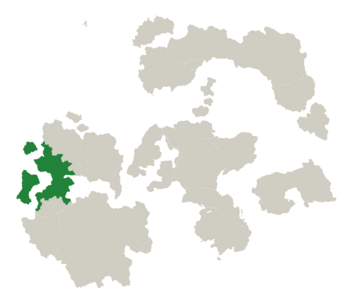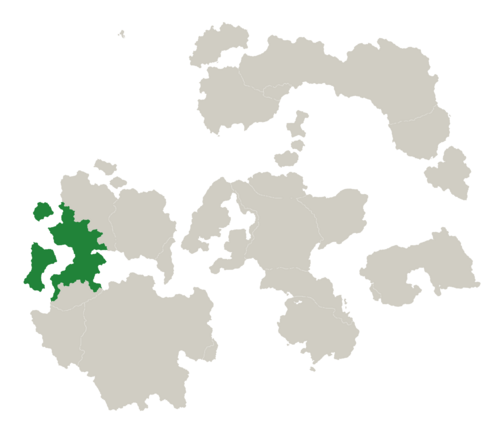Esthursia: Difference between revisions
No edit summary |
|
(No difference)
| |
Revision as of 12:54, 27 January 2022
This article is incomplete because it is pending further input from participants, or it is a work-in-progress by one author. Please comment on this article's talk page to share your input, comments and questions. Note: To contribute to this article, you may need to seek help from the author(s) of this page. |
Union of Esthursia Undebau yr Esddŵrsu | |
|---|---|
| Motto: Y Cywmp Gwan The Weak Fall (Sé Wancol Forwyrd) | |
 Esthursia, upon the west of Auroria. | |
| Status | Federal semi-direct constitutional monarchy |
| Location | Western Auroria |
| Capital | Chartholme 40°15'N, 96°34'E |
| Largest city | Weskerby |
| Official languages | Osynstric, Asthoric |
| Recognised national languages | Osynstric, Asthoric, Ezhoneg, Consence |
| Recognised regional languages | Late Cymbrish |
| Religion (2019) | Irreligious (68.2%), Church of Athers (28.7%), Messianism (1.0%), Other (2.1%) |
| Demonym(s) | Esthursian, Esthur/Esther |
| Government | Unitary parliamentary constitutional monarchy |
• King | Arthur VII (1949-, b. 1930) |
• Forescealc or President | Edmund Newboke (2006-, Labour) |
• Othrescealc or Prime Minister of Osynstry | Jeremy Wilson (2013-, Socialist) |
• Astjórn or Prime Minister of Asþorhelm | Ragnar Þorsenn (2016-, Socialist) |
• First Minister of Ezhonyth | Perran Trefordh (2019-, Ezhoneg) |
• First Minister of Meathere | Morwen Llawyseg (2003-, Maeddyr) |
• First Minister of Consewent | Hedrek Lanenys (2019-, Mebyon Cŵnywr) |
| Capitulation of Caerllwyfen to Classical Osþursian Empire May 11, 298 | |
• Rising of Elmcæstre, Proclamation of Asynstycg | January 15, 466 |
• Oswynht Uprising (Grand Revolution) | August 3, 1161 |
• Democracy Act of Osynstry | November 22, 1303 |
• Union of Osþursia | June 30, 1568 |
• Declaration of Chartholme | February 26, 1622 |
| Area | |
• | 687,011 km2 (265,256 sq mi)Includes rivers and water |
| Population | |
• 2020 estimate | 131,639,574 |
• 2017 census | 129,684,112 |
• Density | 191.61/km2 (496.3/sq mi) |
| GDP (nominal) | 2021 estimate |
• Total | 5,171,006,526,000 IBU |
• Per capita | 39,281.55 IBU |
| Gini (2019) | 26.1 low |
| HDI (2019) | very high |
| Currency | Esthursian royal arian (Ꜹ) (EAN) |
| Time zone | UTC+6, +7 (CWT, WWT) |
• Summer (DST) | UTC+7, +8 (CWT, WWT) |
| First Sunday of March - First Sunday of October | |
| Date format | CE and 3E |
| Driving side | left |
| Calling code | +44 |
| Internet TLD | .oy |
Esthursia, officially the Union of Esthursia (Cymbrish: Undebau yr Esddŵrsu) is a developed sovereign state in the west of Auroria. It is bordered by Weskermere to the east, and Ocean of Consence to the west, with Perran's Channel passing within its borders.
Osynstry, the principal nation of Esthursia, was formed gradually between the fall of Caerllwyfen at the end of the 3rd century, through the Rising in 466, until the Classical Osþursian Empire's recognition of Asynstycg - Osynstry's direct ancestor state - in 514. Thereafter, it slowly grew - especially after the Grand Revolution of 1161 - and unified Osynstry, the fractured Cambrion and Asþorhelm under the Osynstric-led Union of Osþursia thereafter, with this Union cemented and Asynstised in 1622 into the Union of Esthursia.
Esthursia has a long history of infighting that has arguably persisted into the present day, with civil and social unrest in the western extremities continuing, albeit less than in the late 20th century. The nation is renowned for its rich culture, its varied climate which makes it a destination of tourist interest in both summer and winter, and its place in the world stage as an ardent defender of human rights worldwide.
Esthursia is a major member state of the Auronian Economic Alliance, as the previous and current Forescealcs have both pursued for the nation to solidify its place on the world stage.
Etymology
Osynstry is derived from the Old Lower Osynstric "Asynctria" - meaning "synchronised state". This is due to the fact that from a relatively primitive time, Osynstry functioned as a federalised, or localised state under one King. Cymbria is derived from the Cymbric "cwm" - meaning valley - which reflects the terrain that the capital, Yr Gwynydd, resides within. Cymbria ceased to be a homogenous entity between the 1100s - when its final Kings began to lose grip over the external regions - and the 1500s - by which point Cymbrish had more or less lost its mutual intelligibility.
History
Geography
Esthursia is situated in the temperate zone, near Ocean of Consence - from which it receives tropical winds, nicknamed the "Consent Stream" - and between two seas. Weskerby, the capital, is situated on the east peninsula, next to the eponymous Weskermere - and receives a large quantity of rain every year. Apart from the far south, all of the country receives over 500mm of rain a year, with some mountains in the south receiving a smaller amount on some years, distorting the levels and reducing their annual rainfall. The north and south borders are home to the Asthoric and Osynstric mountain ranges respectively. The entire country receives snowfall every year for at least a month, as the rolling hills of the central isthmus provide the perfect climate for snow settling and the Consent Stream weakens from ice melting in the mountains leading to cold water north and south of where it passes during the summer - meaning the temperature often varies, nicknamed the "Frozen" and "Green" winter years.
Regions
Osynstry (south-east) Asthorhelm (north-east) Ezhonyth (mainland, south-west) Meathere (island, south-west) Consewent (island, north-west)
Demographics
General
The population of Esthursia is projected to be 131,639,574, having passed the 130 million mark about two years ago. Population growth has remained steady since the 1990s, driving an equally steady birth rate. 96.9% of Esthursian residents were Esthurs and Esthers (those born within Esthursian borders) at the 2017 census.
Cities
Largest cities or towns in Esthursia
Institute for National Statistics (INS) census data, 2019 | |||||||||
|---|---|---|---|---|---|---|---|---|---|
| Rank | Name | Shire or District | Pop. | Rank | Name | Shire or District | Pop. | ||
| 1 | Weskerby | Brough of Weskerby | 15,894,491 | 11 | Tynwald | The South Vales | 1,426,764 | ||
| 2 | Brantley | Brough of Brantley | 11,701,115 | 12 | Gloucester | Gloucestershire | 1,288,114 | ||
| 3 | Fjármagn | Heðsteð af Fjármagn | 4,268,515 | 13 | Hewesmouth | Esthamptonshire | 1,076,429 | ||
| 4 | Esthampton | Brough of Esthampton | 3,606,273 | 14 | Ancester | Anstershire | 986,917 | ||
| 5 | Execester | Brough of Execester | 3,326,688 | 15 | Ravenscroft | City of Ravenscroft | 910,847 | ||
| 6 | Hereporth | South Hereshire | 2,479,463 | 16 | Atlington | Upper Execestershire | 858,210 | ||
| 7 | Rennezh | Bourc'h an Rennezh | 2,145,840 | 17 | Davenbrook | Davenshire | 731,343 | ||
| 8 | Yeaburn | Brough of Yeaburn | 1,984,827 | 18 | Asgarslow | Asgarshire | 698,240 | ||
| 9 | Sorren | Sorrengard | 1,871,003 | 19 | Helston | Capital District, Merthing | 692,344 | ||
| 10 | Thurrock | Welland | 1,643,840 | 20 | Mereling | Brough of Mereling | 645,634 | ||
Government
The current devolved government in Osynstry is led by the Socialist Democratic Party of Esthursia, whose leader and thus Prime Minister / Othrescealc is Jeremy Wilson. They currently hold 465 seats of 1050 in the House, and 152 of 201 seats in the Senate, not counting the Speakers of both. The Deputy Prime Minister is Harold Osborne, elected by the House after the election. The House uses proportional representation (PR), meanwhile the Senate uses first-past-the-post (FPTP). This results in most administrations controlling a coalition in the House and an outright majority in the Senate, in a move hoped to cause more co-operation. This is the third term for Wilson.
Residing over both houses is the Elder Council and the King. Although they have few powers, they do have the collective power to dismiss leaders and parties. The last time this was used was 1993, upon (Former Prime Minister) Charlotte Greenwood of the Conservative Party.
After the Act of Parliament 2021 passed on November 12, 2021, the Senate and House will now both dissolve on March 15, 2025, to have their election on March 21, 2025.
| Date of poll | J. Wilson (WRK) | O. Ledbury (ATH) | A. Charles (SOC) | R. Gordon (LIB) | A-M. Bailey (GRN-PRG) | H. Stewart (CON) | E. Skipton (COM) |
|---|---|---|---|---|---|---|---|
| 13/11/20 | 45 | 10 | 11 | 8 | 7 | 6 | 4 |
| 12/11/20 | 43 | 11 | 12 | 8 | 6 | 7 | 3 |
| 11/11/20 | 39 | 13 | 13 | 9 | 4 | 8 | 2 |
| 11/11/20 | 38 | 14 | 13 | 8 | 4 | 9 | 3 |
| 10/11/20 | 33 | 16 | 15 | 10 | 3 | 9 | 3 |
| 09/11/20 | 29 | 18 | 16 | 11 | 3 | 10 | 2 |
2020 Election
| Party | Leader | Members of the House | Votes | |||||
|---|---|---|---|---|---|---|---|---|
| Seats | Of total | Seats | Of total | |||||
| Osynstric Workers' Party | Jeremy Wilson | 465 | 44.3% | 465 / 1,050
|
50,981,886 | 44.2% | ||
| Social Liberal Party | Albert Charles | 120 | 11.4% | 120 / 1,050
|
13,184,970 | 11.4% | ||
| Athersic Democrats | Olivia Ledbury | 103 | 9.8% | 103 / 1,050
|
11,317,101 | 9.8% | ||
| Osynstric Liberal Party | Robert Gordon | 98 | 9.3% | 98 / 1,050
|
9,834,392 | 9.3% | ||
| Conservative Party of Osynstry | Howard Stewart | 55 | 5.2% | 55 / 1,050
|
6,043,111 | 5.2% | ||
Economy
The GDP of Osynstry is just over 5 trillion IBU. Economic growth in recent years has remained fairly strong, ranging between 2% and 4%, however some have attributed this to recovering wages from the financial meltdown of 2012-4 coupled with high inflation and a strong arian.
Economic Growth - 2010s
| Year | GDP | GDP per capita | GDP Growth | Population | Population Growth |
|---|---|---|---|---|---|
| 2015 | 7,185,528,620,000 | 45,580.51 | -0.9% | 157,644,759 | +0.19% |
| 2016 | 7,264,569,430,000 | 45,989.92 | +1.1% | 157,960,049 | +0.20% |
| 2017 | 7,286,363,140,000 | 46,026.63 | +0.3% | 158,307,561 | +0.22% |
| 2018 | 7,417,517,680,000 | 46,738.26 | +1.8% | 158,703,330 | +0.25% |
| 2019 | 7,588,120,590,000 | 47,689.25 | +2.3% | 159,115,959 | +0.26% |
| 2020 (projected) | 7,808,176,090,000 | 48,959.63 | +2.9% | 159,481,926 | +0.23% |
Structure
The Esthrsian economy has long been relatively mixed, with recent trends towards nationalisation over the previous 30 years being rather clear.
Under George Asmont, it became clear that the economy would move to be a "social market economy", as he called it - and the utilities became free of charge. He soon instituted reforms to make water, gas and electric completely free to the taxpayer, and the utilities and later broadband became fully nationalised.
A brief period of co-operative capitalism under Thomas Walston - which was well-received as modernisation - was quickly disrupted by Greenwood's neoliberal capitalism, which proved less popular. The ensuing riots and civil unrest over the next 5 years would firmly cause the nation to go back to social markets and nationalisation. The current President, Edmund Newboke, has promised further nationalised reforms over the following five years.
Culture
See History
Infrastructure
Not completed yet




